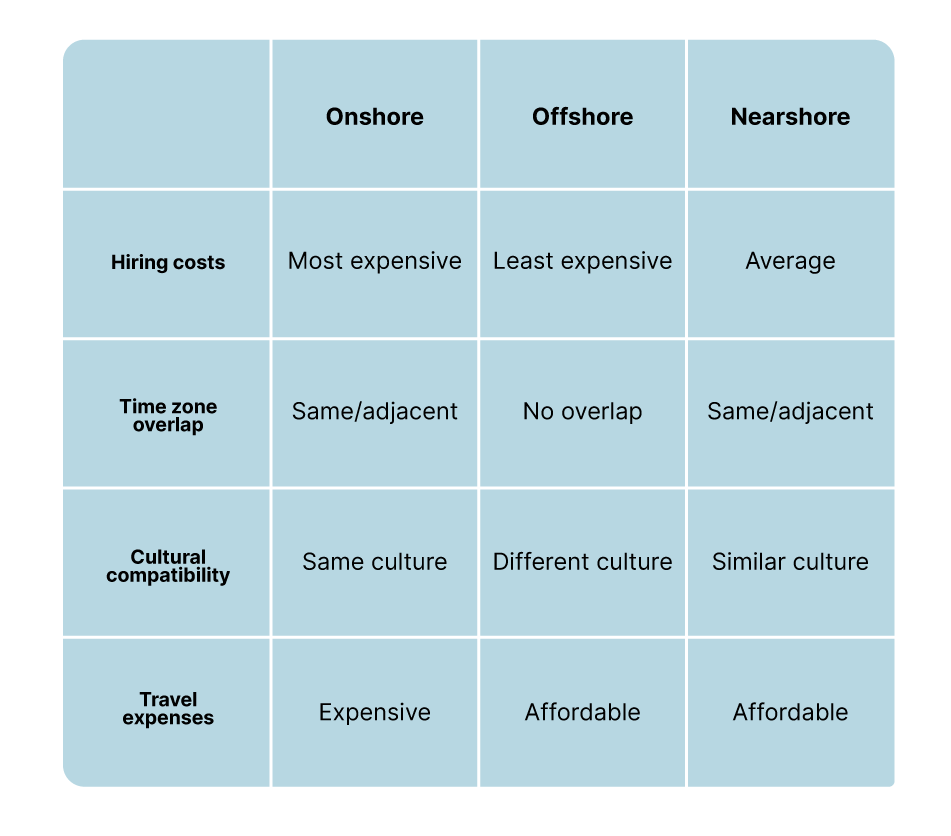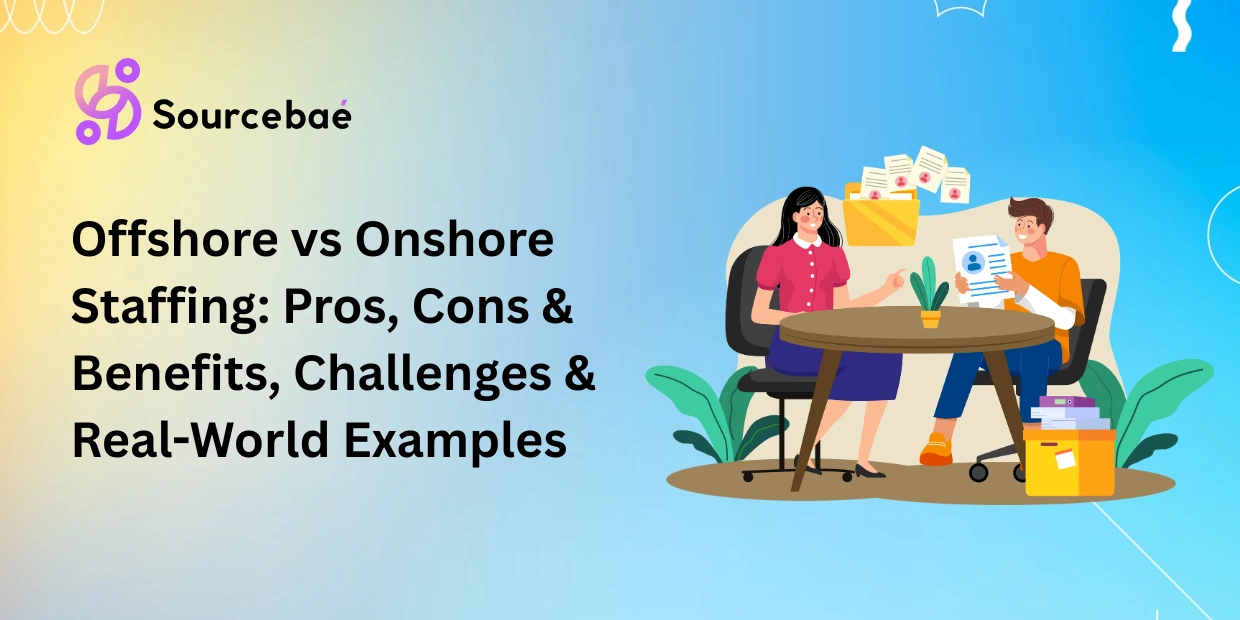Introduction:
In today’s global economy, companies can expand their teams by hiring onshore (domestic) or offshore (abroad) talent. Each model has distinct trade-offs. Offshore staffing (e.g. hiring developers in India) often cuts costs, while onshore staffing (e.g. hiring US-based talent) offers closer collaboration. Businesses may also use contract to hire arrangements – starting workers on temporary contracts that can convert to full-time – in either model. This guide breaks down both approaches, Offshore vs Onshore, advantages and disadvantages, and which might fit different needs.
What Is Offshore Staffing?
Offshore staffing means relocating or hiring business functions in another country (often with lower labor costs). In practice, a U.S. company might use a third-party vendor overseas or open a branch abroad to perform work like software development or customer support. According to Corporate Finance Institute, “offshoring refers to relocating business operations… to a lower-cost location”. Indeed explains that with offshore labor “a company… transfer[s] some portion of their operations to a different country” for benefit. Companies offshore to save money and tap global expertise.
Pros of Offshore Staffing
Offshore staffing offers significant benefits, especially on cost and talent:
- Lower Labor Costs: The biggest advantage is cost savings. Wages and overhead abroad can be a fraction of onshore levels. For instance, an offshore developer’s fully‑loaded cost can be nearly half of a local hire. Savings from cheaper labor and infrastructure translate directly to higher profit margins.
- Access to Global Skills: Offshore opens a global talent pool. Companies can find specialized skills or higher-volume teams (e.g. hiring in India or the Philippines) that may be scarce or too expensive at home.
- 24/7 Productivity: By distributing work across time zones, companies can achieve near round-the-clock development. Teams overseas can continue projects when the home office sleeps, effectively doubling throughput.
- Scalability and Flexibility: Offshore makes it easy to scale quickly. Lower costs let firms grow headcount or facilities more rapidly. Companies can reinvest savings into expansion – hiring more staff or developing new products.
- Tax and Incentive Benefits: Some countries offer tax breaks or incentives to foreign firms. Offshore sites may have lower corporate taxes or government subsidies, reducing the company’s overall tax burden.
Case Study: Tech leader Apple dramatically reduced production costs by offshoring manufacturing. Apple outsourced iPhone assembly to Foxconn (China) and other partners, allowing it to meet soaring demand and cut costs. For example, the iPhone 15 Pro Max costs Apple ~$558 to build but retails for $1,199–1,599. By offshoring, Apple focused its U.S. teams on design and innovation. Similarly, Microsoft used offshore R&D teams to accelerate innovation and cut costs without sacrificing quality.
Cons of Offshore Staffing
Offshoring also poses challenges that companies must manage:
- Communication Barriers: Geographic and cultural distance can hinder communication. Language differences and time-zone gaps lead to misunderstandings and delays. Even with modern tools, “offshoring can introduce challenges related to communication, time zone differences, and cultural barriers”.
- Time Zone Differences: Work hours rarely overlap. If the U.S. team is awake, offshore staff may be asleep, making real-time coordination difficult. Urgent issues can go unresolved for hours.
- Quality Control: Managing quality from afar is tougher. Without in-person oversight, companies must invest in stringent QA processes. Offshore facilities may not meet the same standards, so clear guidelines are critical.
- Security and IP Risk: Transferring sensitive data or proprietary work abroad raises security and legal issues. Different countries have varied data protection laws; companies worry about intellectual property leakage.
- Cultural Differences: Different work cultures and norms can affect teamwork. When teams don’t share the same business culture or language nuances, it can slow projects or affect morale.
- Brand and Morale Concerns: Shifting jobs overseas can spark negative PR or hurt domestic employee morale. Outsourcing labor can be seen as abandoning local communities, which some brands avoid.
What Is Onshore Staffing?
Onshore staffing (or onshore outsourcing) means hiring workers or vendors within your own country or region. For example, a U.S. company might contract another U.S. firm or local temp agency to fill roles. The entire team operates under the same national context. Outbooks defines it as outsourcing work “from within the organization’s own home country.” In practice, an onshore team shares the client’s time zones, language, and legal environment.
Pros of Onshore Staffing
Onshore staffing’s strengths revolve around proximity and control:
- Easy Communication: Teams share the same language and culture, so there are no language or time-zone barriers. You can have real-time discussions or in-person meetings. Onshore staff work your hours, enabling instant feedback.
- Legal and Regulatory Alignment: Onshore teams operate under the same laws, tax rules, and standards. This uniform compliance simplifies contracts, payroll, and data protection. IP and security protections tend to be stronger and consistent when everyone is in one jurisdiction.
- Quality Control and Oversight: Working locally means easier oversight. Managers can visit the vendor’s office or co-locate teams. This boosts transparency and accountability. As ManekTech notes, same-location teams offer “greater quality” and faster issue resolution.
- Strong Collaboration: Physical proximity builds trust and teamwork. On-site or local teams often have higher morale and cohesion. You can align on company values and work closely on strategy.
- Support Local Economy: Onshoring stimulates domestic jobs and can be good PR. Many companies promote onshore efforts to appeal to customers and governments.
Example: An American startup needing urgent legal or customer support might hire a U.S. firm onshore to get immediate, culturally-aligned help – even at higher cost. The local firm can attend same-day meetings and better understand U.S. business norms.
Cons of Onshore Staffing
Onshore staffing’s drawbacks are mainly economic and resource-related:
- Higher Costs: Onshore labor rates and overhead are generally much higher. Salaries, benefits, and taxes in developed countries are greater. ManekTech notes that onshore developer rates can “end up being a costly affair”. TalentJDI’s analysis showed onshore hiring costs (in Singapore vs Vietnam) were nearly double. In short, onshore is “most expensive”.
- Limited Talent Pool: Relying solely on domestic workers can mean a smaller candidate pool. In some markets, experts in niche skills may be scarce. ManekTech points out that onshore staffing can lead to an “overfished pool of talent,” making it hard to find specialized skills locally.
- Scalability Constraints: Rapidly growing projects may be bottlenecked by available local talent. You might hit “ceiling” on how many qualified people are onshore.
- Hidden Overheads: Beyond wages, onshore outsourcing brings local costs for training, facility expansion, and management. These expenses are usually higher and can erode the value of outsourcing.
- Time and Convenience Trade-offs: While onshore means easy collaboration, it may lack the continuous (24/7) advantage of offshore. For global businesses, having all teams on the same time zone can leave nights unattended.
Offshore vs Onshore Outsourcing: Advantages and Disadvantages
Choosing offshore or onshore is a balance. The chart below summarizes key differences:

- Cost: Offshore is the cheapest option, while onshore is the most expensive. Nearshore (neighboring country) lies in between with moderate costs.
- Time Zone: Onshore teams work in the same or adjacent time zone as you (minimal lag); offshore teams often have no overlap, which can delay communication. Nearshore teams usually share similar time zones, easing collaboration.
- Culture/Language: Onshore and nearshore staff generally share culture and language with you, ensuring smoother integration. Offshore teams bring cultural diversity (an advantage if managed well, but also a challenge for cohesion).
- Control & Security: Onshore provides the highest level of control, legal alignment, and IP protection. Offshore can risk confidentiality but offers innovation and global knowledge.
- Collaboration: Working onshore enables face-to-face meetings and quick team huddles. Offshore requires disciplined remote management.
- Scalability: Offshore wins on sheer scale and flexibility – it’s easier to expand staff count overseas. Onshore may cap growth if local talent is limited.
Which Is Better: Onshore or Offshore?
There’s no one-size-fits-all answer. The “better” choice depends on your business goals and priorities. If cost-cutting and rapid scaling are paramount, offshore staffing can be ideal. If quality control, speed of collaboration, and data security are more critical, onshore may be worth the premium. As one industry guide notes, the answer “can be found within the company”: executives should assess what matters most for their operations. Often, companies use a mix – e.g. core, customer-facing roles onshore, and cost-heavy tasks offshore.
In practice, weigh factors like budget, project complexity, and required expertise. For example, a tech startup might offshore some development to launch quickly, while keeping product strategy onshore. A financial firm handling sensitive data might prioritize onshore for compliance. Considering a nearshore (neighboring country) model can sometimes offer a middle ground – combining closer collaboration with lower costs than pure onshore.
Why Onshoring Is More Expensive Than Offshoring
Onshore staffing tends to be pricier because of higher wages, benefits, and overhead in developed economies. Workers in the U.S./Europe command much higher salaries than counterparts in lower-cost countries. For instance, Jobsity reports an average U.S. tech salary ≈$152K/year, whereas offshore developers in Asia or Latin America may earn under $40K. Benefits, healthcare, taxes, and compliance costs are also higher onshore. Land, utilities, and other operating expenses add up. A study by TalentJDI found onshore hiring costs nearly double offshore for a given skill set. In short: the same role overseas costs far less than stateside, explaining the classic cost gap.
Which Is Right for Your Business?
To decide, list your key criteria:
- Cost Budget: If tight, lean offshore or nearshore to maximize ROI.
- Talent Needs: For niche skills not available locally, offshore widens the search.
- Quality & Control: If your project demands strict oversight or local market knowledge, onshore is safer.
- Speed & Collaboration: Need instant communication? Onshore/nearshore teams allow same-day meetings.
- Data Sensitivity: Highly sensitive work often stays onshore to ensure compliance.
- Long-term Strategy: Some industries mix both – core team local, expansion offshore. For example, a U.S. software firm might keep product design at HQ while offshoring routine coding.
Also consider Offshore vs Onshore models with either approach. Offshore vs Onshore lets you test a candidate’s fit before committing. It’s common in both onshore and offshore staffing. Services like Sourcebae support global Offshore vs Onshore by automating recruitment and vetting talent worldwide. This means you can flexibly sample onshore or offshore candidates and convert the best to full-time hire.
Call to Action: To streamline this process, Sourcebae’s AI-driven recruitment platform can help you source and evaluate talent across locations. Whether you need immediate local support or want to tap international experts, Sourcebae connects you quickly with pre-vetted candidates to build your dream team.
Conclusion
Both offshore and onshore staffing have clear pros and cons. Offshore staffing can dramatically cut costs and tap global expertise, but requires managing remote teams. Onshore staffing offers easier oversight and communication at a premium price. The right choice depends on your company’s priorities, project requirements, and resources. Often a hybrid or nearshore compromise emerges as the best solution. By analyzing needs and perhaps leveraging a smart hiring platform, businesses can optimize their mix of onshore and offshore talent. Whether you prioritize savings or speed-to-market, understanding these trade-offs ensures an informed staffing strategy.
FAQs
What is the difference between onshore and offshore staffing?
Onshore staffing means hiring talent within your own country; offshore staffing means hiring workers in another country (usually where costs are lower). Onshore teams share your time zone and culture; offshore teams bring cost and talent advantages from abroad.
What are the advantages of offshore staffing?
Key benefits include much lower labor costs (hence higher profitability), access to a large global talent pool, and the ability to operate 24/7 by leveraging time-zone differences. Offshore can also unlock tax incentives and rapid scaling.
What are the advantages of onshore staffing?
Onshore teams enable smooth communication (same language and overlapping work hours), better legal and regulatory alignment, and tighter quality control. You can meet face-to-face and ensure IP security under familiar laws. Onshoring also supports local economies and brand image.
Which is better: onshore or offshore?
Neither is universally “better” – it depends on your goals. If minimizing costs and quick growth are most important, offshore wins; if collaboration, speed, and control matter more, onshore may be better. Many companies use a mix (hybrid model) or choose nearshore (close-but-abroad) to balance pros and cons.
Why is onshoring typically more expensive than offshoring?
Because domestic labor markets have higher wages, benefits, and overhead. For example, U.S. tech salaries average well over $150K, while offshore regions often pay a fraction. Employment taxes, healthcare, and facility costs also inflate onshore rates. This wage gap makes onshore staffing significantly costlier.
What is nearshore staffing?
Nearshoring is outsourcing to a neighboring country or one in a similar time zone (e.g. U.S. firms hiring in Mexico or Eastern Europe). It combines some benefits of offshoring (lower costs than onshore) with advantages of proximity (short flights, overlapping hours). Nearshore can be a compromise between the two.
What is contract-to-hire staffing?
Contract-to-hire is when a company brings on a worker on a trial contract (temp) before making them a permanent hire. It lets both employer and worker “try out” the role. This model can be used with either onshore or offshore candidates. It reduces hiring risk by ensuring a fit before a full-time commitment.
How do I decide the best staffing model for my company?
Evaluate your priorities: budget vs. control, skill needs, and risk tolerance. Tech startups might value offshore for cost, while enterprises needing security might stick onshore. You can mix models or use nearshore. Platforms like Sourcebae can simplify finding and vetting both onshore and offshore talent, helping you make the optimal choice. For tailored advice, consider consulting staffing professionals or using modern recruiting tech to assess candidates globally.






